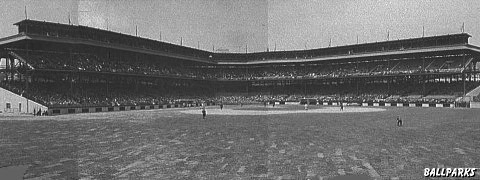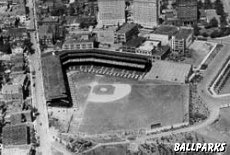Forbes Field
Pittsburgh, Pennsylvania
Tenant: Pittsburgh Pirates (NL)
Opened: June 30, 1909
First night game: June 4, 1940
Last game: June 28, 1970
Demolished: July 28, 1971
Capacity: 25,000 (1909); 35,000 (1938)
Surface: Grass
Architect: Osborn Engineering
Builder: Nicole Construction Company
Owner: Pittsburgh Pirates
Cost: $1 million, including property acquisition (1909)
Pittsburgh Pirates tickets:
Location: Two miles east of downtown Pittsburgh and just northwest of Schenley Park in the southern part of the University of Pittsburgh campus. Left field (NE), Schenley Drive (Bigelow Boulevard, Forbes Field Avenue, Pennant Place); third base (NW), Sennott Street (now gone), then Forbes Avenue; first base (SW) Boquet Street; right field (SE), none in the immediate vicinity, but Joncaire Street was the closest street in that direction.
Dimensions: Left field: 360 (1909), 356.5 (1921), 356 (1922), 360 (1926), 365 (1930), 335 (1947), 365 (1954); deepest corner, left of straightaway center, at the flagpole: 462 (1909), 457 (1930); center field 442 (1926), 435 (1930); right-center, right side of exit gate: 416 (1955); right-center: 375 (1942); bend at left end of screen: 375; right field: 376 (1909), 376.5 (1921), 376 (1922), 300 (1925); backstop: 110 (1909), 84 (1938), 80 (1947), 84 (1953), 75 (1959).
Fences: Left-field front fence: 8 (5 screen above 3 wood, 1947), 12 (9 screen on top of 3 wood, 1949), 14 (screen, 1950); left-field wall: 12 (1909), 12 (brick and ivy, 1946); left-field scoreboard: 25.42 (steel left and right sides), 27 (middle); wooden marine sergeant at parade rest to right of scoreboard: 32 (June 26, 1943, to end of season); side wall angling back to meet brick wall in left-center: 12 (wood, when front fence was up); cages around light tower just right of scoreboard and in power alleys: 16.5; center field: 12 (wood, 1909), 12 (brick and ivy, 1946); right-center: 9.5 (concrete, 1925); screen - left side at 375 Mark: 24 (14.5 wire above 9.5 concrete, 1932); screen - right side at flagpole: 27.67 (18.17 wire above 9.5 concrete, 1932).
Forbes Field Trivia:
- First base is by a misspelled street. Boquet Street was named for General Henry Bouquet, a Swiss soldier who fought for the British in the French and Indian War’s decisive battle at Fort Duquesne.
- The field was named for General John Forbes, a British general in the French and Indian War who captured Fort Duquesne and renamed it Fort Pitt in 1758.
- Ivy-covered brick wall in left and left-center.
- The 14-foot Longines clock with speaker horns on top of the left-field scoreboard was out of play - a drive hitting it was a home run.
- Fans in the upper-left corner of the left-field bleachers could not see the plate because of the third base grandstand, which stood between them and the plate.
- The right-field roof was 86 feet high.
- Stadium was built on the site of a football game between the University of Pennsylvania and Carnegie Tech on October 31, 1908. Penn won on the rocky field.
- The University of Pittsburgh’s Posvar Hall currently occupies the former infield. The center-field and right-center brick walls still stand, along with the base of the flagpole. Mazeroski Field, a Little League diamond beyond the left-field brick wall, still remains. Roberto Clemente Drive now bisects the site and runs about 10 feet under what used to be the playing surface of the outfield.
- During World War II the right-field screen could not be replaced because of the priority given to the war effort. It deteriorated badly.
- A no-hitter was never pitched there.
- Home plate remains in almost its exact original location, but it is now encased in glass on the first-floor walkway of the University of Pittsburgh’s Posvar Hall.
- The bottoms of the light-tower cages in left-center, center, and right-center were in play, as was the bottom of the center-field flagpole.
- Just to the left of the flagpole stood the batting cage, also in play. Before being placed in left-center, the batting cage was situated behind home plate.
- Very hard infield surface caused bad hop that knocked out Yankees shortstop Tony Kubek during the last game of the 1960 World Series which the Pirates won.
- Back in the 1910s there was a small scoreboard on the center-field wall.
- In the 1920s cars and trucks were repaired and sold beneath the left-field bleachers.
- Right-field stands were built in 1925, reducing the distance to the right-field foul pole by 76.5 feet. The right-field screen was added in 1932. It was taken down for a short period and then put back up.
- Barney Dreyfuss Monument was just to the left of the exit gate in right-center where fans exited the ballpark into Schenley Park after games. It was installed on June 30, 1934, on the park’s 25th anniversary and was made of granite with a bronze tablet.
- Greenberg Gardens (also called Kiner’s Korner) was the area between the scoreboard and a chicken-wire short fence in left put there to increase home run production from 1947 to 1953. It was called Greenberg Gardens in 1947, Kiner’s Korner from 1948 to 1953.
- When Greenberg Gardens were in place, a Western Union clock stood on top of the scoreboard, to the right of the familiar Gruen Clock.
- In 1938, with the Bucs apparently on their way to the World Series, they built a third deck of seats behind the plate called the Crow’s Nest, which boasted the major leagues’ first elevator. The Bucs finally made the Series--22 years later.
- Babe Ruth stroked the last three home runs of his career at Forbes Field on Saturday, May 25,1935 in front of about 10,000 fans. It was reported in the papers several days later that the final blow, which was the first ever to clear the then 10 year old right field roof, came to rest on the roof of 318 Boquet Street, a rowhouse which survives to this day. The ball was reportedly retrieved by Gus Miller, then chief of the Forbes Field ushers.
- During World War II, from June 26, 1943, through the end of the season, a huge U.S. Marine made of wood stood against the left-field wall, just to the right of the scoreboard. Standing at parade rest, the Marine Sergeant was 32 feet high, 15 feet wide across his feet, and in play.
- A Honus Wagner statue was erected in Schenley Park in 1955. It stands 18 feet high, weighs 1,800 pounds, and was moved to Three Rivers Stadium along with the Bucs in 1970.
- It was here, in May 1956, that Dale Long homered in his eighth game in a row, a major league record.
- Today a plaque marks the spot where Bill Mazeroski’s World Series-winning homer left the park in 1960 and flew into the trees above Yogi Berra’s head.
- Hosted the 1959 (I) and 1944 All-Star games.
- Green foam-rubber crash pads placed on the concrete wall in right and right-center were the first in the majors. Wooden walls installed in left and center in 1909 were replaced with brick and ivy in 1946.
- Street dead-ending into Sennott Street by third base was called at various times Pennant Place and Forbes Field Avenue.
- Sold for $3 million in 1958.
- Fires damaged park on December 24, 1970, and July 17, 1971. Demolition began on July 28, 1971.
Recommended Reading (bibliography):
- Forbes Field: Essays and Memories of the Pirates' Historic Ballpark, 1909-1971 by David Cicotello & Angelo J. Louisa.
- Forbes Field: Build-It-Yourself: With an Introduction and History by Len Martin.
- Take Me Out to the Ballpark: An Illustrated Tour of Baseball Parks Past and Present by Josh Leventhal and Jessica Macmurray.
- The Ballpark Book: A Journey Through the Fields of Baseball Magic (Revised Edition) by Ron Smith and Kevin Belford.
- City Baseball Magic: Plain Talk and Uncommon Sense about Cities and Baseball Parks by Philip Bess.
- Diamonds: The Evolution of the Ballpark by Michael Gershman.
- Green Cathedrals: The Ultimate Celebration of All 273 Major League and Negro League Ballparks by Philip J. Lowry.
- Lost Ballparks: A Celebration of Baseball's Legendary Fields by Lawrence S. Ritter.
- Roadside Baseball: A Guide to Baseball Shrines Across America by Chris Epting.
- The Story of America's Classic Ballparks (VHS).
Help us provide a better web site by completing our feedback form
PHOTOGRAPHS:
Panoramic view of Forbes Field in 1909 courtesy of Detroit Publishing.
Forbes Autumn Classic © 1991 by Bill Purdom.
Forbes Field Entrance courtesy of the Franklin Digital Collection.
Aerial view of Forbes Field in the 1960s courtesy of the Pittsburgh Pirates.
Aerial view of Forbes Field in the 1920s courtesy of the University of Pittsburgh.
Forbes Field and the Cathedral of Learning courtesy of the Carnegie Library of Pittsburgh.
Forbes Field scoreboard source is unknown.
Special thanks to Glenn E. Gearhard and James Zilch.
Updated January 2008
Tickets to MLB All Star game, NCAA Basketball Tournament, College Football Bowl, NCAA Football, Paul McCartney and Pittsburgh Pirates provided by Ticket Triangle.
BALLPARKS © 1996-2014 by Munsey & Suppes.
|










